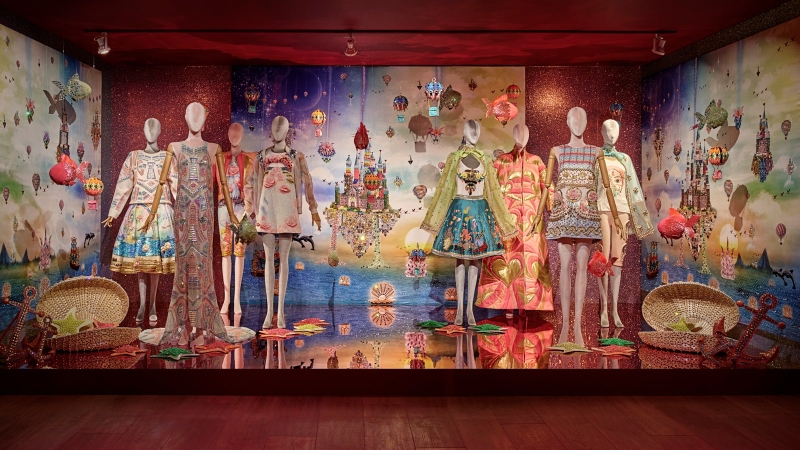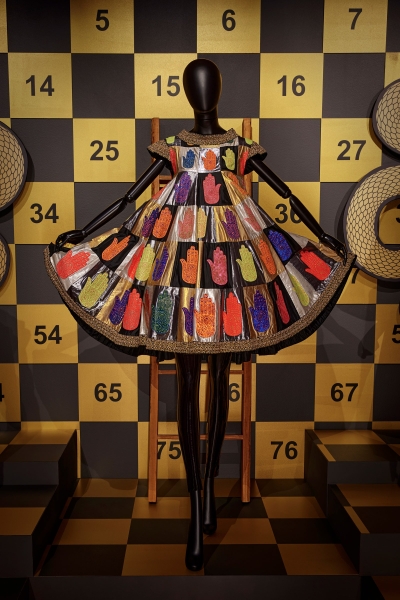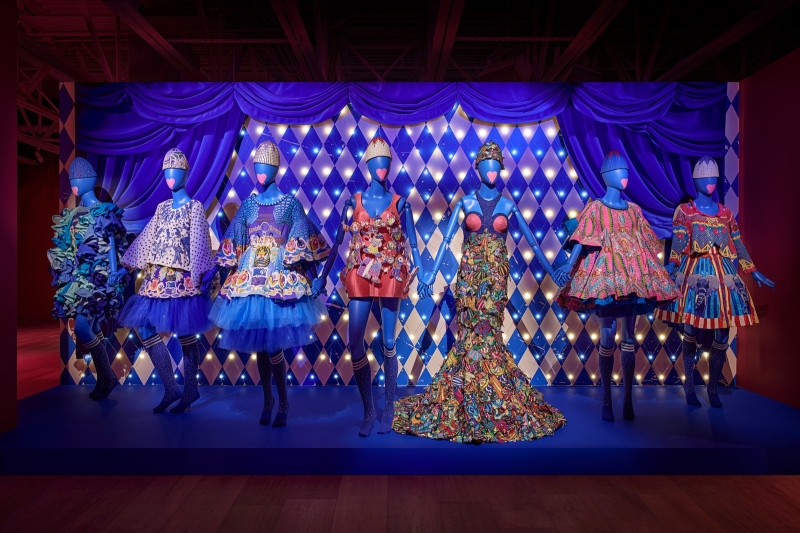
One of Manish Arora’s most sentimental garments may surprise you. Alongside all the designer’s glittering more-is-more maximalist gowns covered in baroque-like gilding and a paradise of hand-embellishment is a simple fuschia button-down shirt. Stamped with small but mighty silver metallic florals–it debuted at one of his first collections in the late 1990s and was owned by one of his late great friends, Catherine Levy, who always joked that she’d one day give the shirt to a museum. And so, her wish became reality when the exhibition Manish Arora: Life Is Beautiful opened at SCAD FASH Museum of Fashion + Film in Atlanta this week. It’s the first major retrospective for the designer–and one of the rare few solo fashion exhibitions dedicated to an Indian fashion legend who’s work, in his own words, “could only be designed by an Indian designer.”
Known for his iconic statements like “pink and gold are my religion,” Arora has been creating wearable maximalist fantasies since the late 1990s. Think: colorfully textured pieces layered with references as far flung as Burning Man to the trance dance parties of Goa. It’s over the top, decadent and opulent; it's extra. Beginning in the early 2000s, Arora became one of the first major Indian designers to show at London Fashion Week and Paris Fashion Week–also taking on a short stint as creative director of Paco Rabanne in the early 2010s. His influence is wide–dressing the likes of Katy Perry, Lady Gaga, Nicki Minaj and more–and standing in as one of the most extreme and over-the-top designers in Paris for years.
Along with Rafael Gomes, director of fashion exhibitions at SCAD FASH, Arora painstakingly contacted his biggest collectors and clients throughout the years to secure pieces for the show. “It was fun to get in touch with people I haven’t spoken to for 15 years,” Arora tells Vogue. “A lot of people were very enthusiastic, a lot of people were not sure, but in the end, I think we did very well.”

Sitting inside SCAD’s museum on a cool Atlanta afternoon—his nails painted gold, his fingers stacked with fistfuls of glimmering gold rings, his outfit slightly metallic and layered with tailoring—he explains that most of the pieces in the show are, in fact, one-of-a-kind. “Some of these pieces, I didn't even own,” he says. “I didn’t collect my archives so we got together and got in touch with people and got them. These pieces are like nothing that you will ever find anywhere else.” One example? A Paris-themed rainbow skirt depicting the Eiffel Tower, Arc de Triomphe and the Moulin Rouge’s famous Can-Can dance in action, among other landmarks. It’s chain stitched by hand–approximating hours and hours and hours of work, akin to couture-level fashion. “It’s typical cliche Paris, but it’s one of my favorite pieces,” he says. “It was impossible to reproduce, so there’s only one.”
Inside the exhibition, a feast for the eyes manifests in the form of different dream-like scenarios. There’s a dessert-themed wall anchored by crystal-covered ice cream cones and cupcakes, and a fantasy section, flanked with imagery of pastel skies and floating fabric castles. The show is divided into 13 themes that best represent the designer’s body of work. There’s also a rare glimpse into his legendary jewelry pieces–which play with ideas of traditional ceremonial dress and whimsy (pineapples, gingerbread houses and unicorns abound). On the walls, there are archive and childhood photographs of Arora himself with hand-written notes: “My first time in drag,” one reads. A handbag shaped like a milkshake, a Swarovski crystal dress rendered of jigsaw puzzle pieces and a floor-length gown complete with a train and composed entirely out of leather-like butterflies. There is a lot to see.
For his biggest fans, it’s a welcome celebration–the designer’s last collection was presented for fall 2020, and since then he’s moved his focus to food with his own cookbook and a series of restaurant pop-ups. But while the designer’s extravagant creations proved truly something exceptional to behold when they came down the runways, seeing them up close provides a rare look at just how detailed the work is. Every ounce of embellishment is done by hand, after all. And even if you don’t immediately recognize it, there’s a deep nod to his heritage and the ancient techniques and crafts so associated with India. “We need to have this tradition going on in our country. We must continue it and to continue it, one must modernize it,” he says. It only takes one look at a jacket in the exhibition (embroidered with gummy bear and jelly bean shapes) to see exactly what he means.


“A lot of times when you speak to these embroiderers, they would be quite fed up of just recreating historical motives or history,” he adds. “They're very excited to do something new. That is also one of the reasons I think one must modernize it rather than just continuing and reproducing. So that's what I would like to continue.”
Much of the work shown in the exhibition is littered with fashion that explores cultural references with twists turned on their head. A dress covered in images of weather-faded Bollywood icons, not like you’d see on a billboard, in the pages of a glossy magazine or in a fancy cinema, but the exact kind you’d see plastered on an everyday salon window in India. Pieces that mix Lichtenstein-like characters with Vishnu and turn his comic book speech balloons into feminist-fueled dotings rather than damsel-in-distress musings. “She is so beautiful, I am so lucky to have her as my wife,” one reads.
“My work is such that it can be easily understood by everybody, but yet only an Indian could have done it,” Arora says, who resides in Paris full-time now. “Hopefully people who come here will feel happiness, joy and celebration. That's the idea of the exhibition.” While Arora doesn’t have any plans to revive his label–just yet–this immersive show will keep both his most nostalgic fans and his newest supporters dreaming, at least until August 2024, when it ends.


